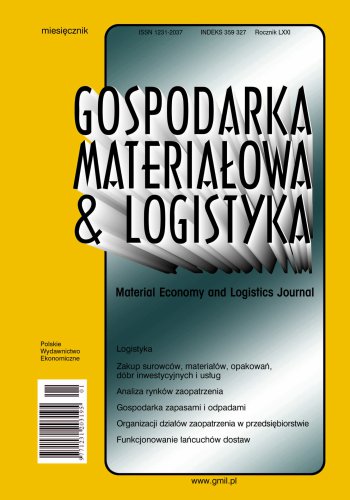The logistics control system for container vessels in the tandem sea port
System sterowania logistyką kontenerowców w porcie morskim typu tandem
The paper solves the problem of controlling the handling of container ships in a tandem seaport. The control system for container ships includes determining the route of ships taking into account random disturbances, ship transport time and the time of unloading/loading. Determining the optimal route of ships is an NP problem. The ship service process is scheduled on a weekly basis. However, the tugboats operate in a shift cycle. It is important to designate a warehouse/wharf where containers are to be unloaded/loaded and to determine restrictions. The port consists of a roadway, ships, unloading and loading quays, canals, and warehouses and can have various structures. It is assumed that the ships await service in the port roadstead. The time horizon for the allocation is one week. Ships waiting in the roadstead have priorities depending on the waiting time. It is assumed that the time of transport, unloading/loading of the vessel and economic parameters are given. The optimization of ship service in the port is multi-criteria. There are entry, exit and internal criteria. The problem of controlling container ships in a tandem seaport was solved by the method of artificial intelligence using a computer program. The optimization criterion was the minimization of vessel service time in both parts of the port, taking into account restrictions. A logistics system for controlling ships in a tandem seaport with averaged data and random events was developed.
Artykuł został poświęcony zagadnieniu kontroli obsługi kontenerowców w tandemowym porcie morskim. System sterowania kontenerowcami obejmuje wyznaczanie trasy statków z uwzględnieniem zakłóceń losowych, czasu transportu statku oraz czasu rozładunku/załadunku. Wyznaczenie optymalnej trasy statków jest problemem klasy NP. Proces obsługi statku planowany jest co tydzień, jednak holowniki działają w cyklu zmianowym. Ważne jest to, aby wyznaczyć magazyn/nabrzeże, w którym kontenery mają być rozładowane/załadowane, oraz wyznaczyć ograniczenia. Port składa się z tras, statków, nabrzeży rozładunkowych i załadunkowych, kanałów oraz magazynów i może mieć różne konstrukcje. Zakłada się, że statki oczekują na obsługę na redzie portowej. Horyzont czasowy alokacji ustalono na jeden tydzień. Statki oczekujące na redzie mają priorytety zależne od czasu oczekiwania. Zakłada się, że podano czas transportu, rozładunku/ załadunku statku oraz parametry ekonomiczne. Optymalizacja obsługi statków w porcie jest wielokryterialna, tzn. że istnieją kryteria wejścia, wyjścia i kryteria wewnętrzne. Zaproponowano rozwiązanie problemu sterowania kontenerowcami w tandemowym porcie morskim za pomocą metody sztucznej inteligencji z wykorzystaniem dedykowanego programu komputerowego. Kryterium optymalizacji była minimalizacja czasu obsługi statków w obu częściach portu z uwzględnieniem ograniczeń. Opracowano system logistyczny przeznaczony do sterowania statkami w tandemowym porcie morskim z uśrednionymi danymi i zdarzeniami losowymi.
Bibliografia
References/Bibliografia
Bucki, R. (2012). Information logistics. Institute of Management and Information Technology in Bielsko-Biała.
Bucki, R. et al. (2013). Proceedings of the International Workshop: Information Logistics. Institute of Management and Information Technology in Bielsko-Biała.
Bucki, R. et al. (2014). Information logistics. Institute of Management and Information Technology in Bielsko-Biała.
Bucki, R., & Marecki, F. (2006). Digital simulation of discrete processes. Network Integrators Associates.
Bucki, R., Frąckiewicz, Z., & Marecki, F. (2010). The Information system for servicing ships in the port. Optimization and simulation methods. Project: Information Logistics of Transport, Production and Storing Systems, Id. No. MEB051024. Faculty of Applied Informatics, Tomas Bata University in Zlín, 10–12 November 2010, 43–47.
Frąckiewicz, Z., & Marecki F. (2020). The innovative IT system for handling ships in a container port. Management, economy and finances in the face of the challenges of the computerized world.
Harel, D. (1987). Algorithmics. The spirit of computing. The Weizmann Institute of Science.
Joszczuk, J. (1991). The computer system for managing the movement of ships in limited areas [Dissertation, PAN].
Kaku, M. (2014). The future of the mind: The scientific quest to understand, enhance, and empower the mind. Doubleday.
Królikowski, S., & Wolski, A. (1988). The radar vessel traffic control system in the Szczecin-Świnoujście fairway. Technology and Maritime Economy, (4), 164–168.
Marecki, J., & Marecki, F. (2007). Service of ships at ports. Information logistics. Institute of Management and Information Technology in Bielsko-Biała.
Papadimitriou, Ch. H. (2002). Computational complexity. Pearson.
Robling-Denning, D. E. (1982). Cryptography and Data Security. Addison Wesley Publishing Company.
Vessel Tracking System — market size, share, industry forrecast (2020). https://www.fortunebusinessinsights.com.
Wirth, N. (1976). Algoritms + data structure = programs. Prentice Hall. Series in Automatic Computation.

